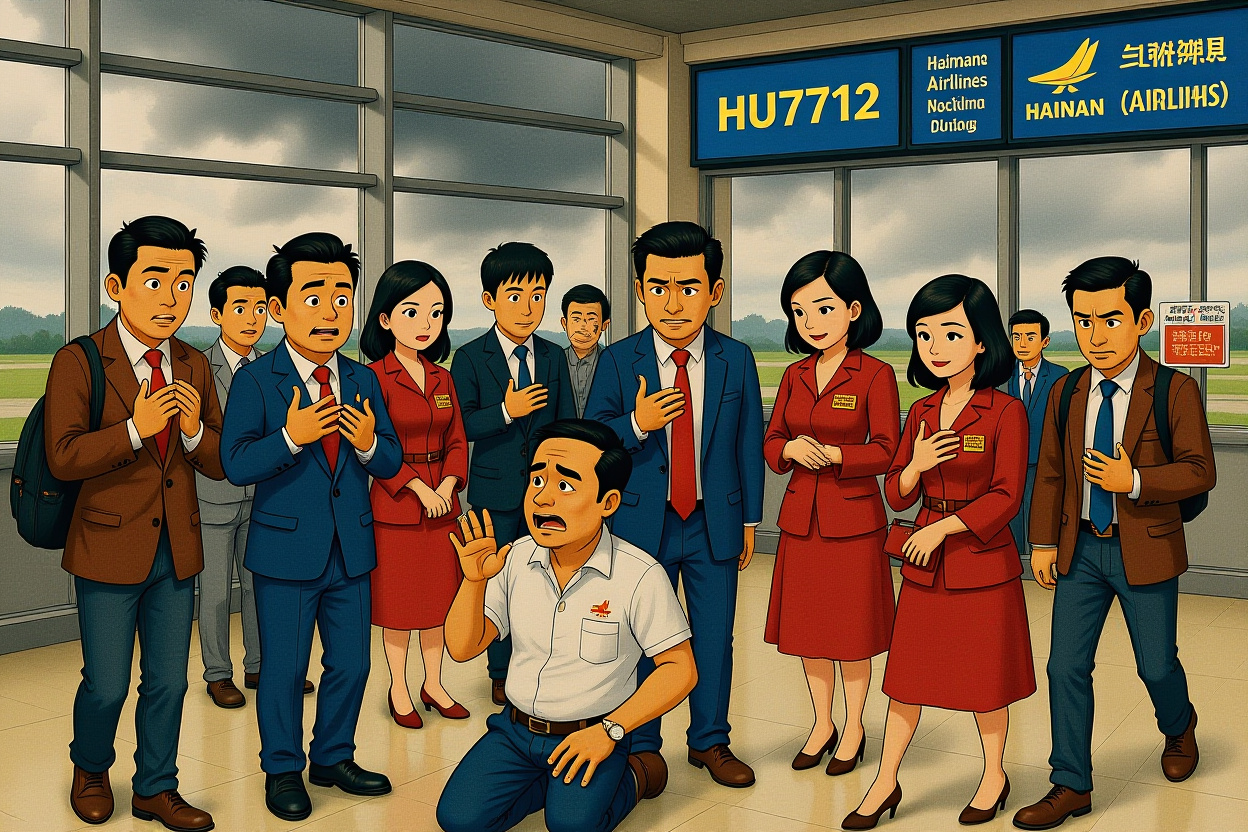Weather Emergency Forces Flight Diversion to Taiyuan
On September 9th, Hainan Airlines (海南航空) flight HU7712 from Shenzhen to Beijing became entangled in a dramatic operational scenario when severe weather conditions forced an unscheduled diversion to Taiyuan Wusu International Airport (太原武宿国际机场). The incident, occurring during peak travel hours, exposed both the vulnerabilities of air travel to meteorological conditions and the complex decision-making processes airlines must navigate during emergencies.
Timeline of Disruption
According to flight tracking data from VariFlight (飞常准) and industry monitoring systems, the aircraft departed Shenzhen Bao’an International Airport (深圳宝安机场) at 18:25 as scheduled, with original arrival anticipated at Beijing Capital International Airport (北京首都机场) at 21:15. At approximately 22:38, the aircraft executed a safe landing in Taiyuan after air traffic control determined Beijing’s weather conditions exceeded safety parameters for landing operations.
The Civil Aviation Administration of China (中国民用航空局) maintains strict weather minimums for landing operations, particularly during summer monsoon season when convective activity frequently impacts northern Chinese airports. Flight diversions due to weather represent standard safety protocol rather than operational failure, though they inevitably create passenger inconvenience.
Passenger Crisis Emerges During Diversion
The diversion triggered acute distress among passengers with time-sensitive commitments in Beijing. Most notably, one passenger requiring medical surgery the following morning resorted to kneeling before ground staff in desperate appeal for assistance—a moment captured on video and subsequently circulating across Chinese social media platforms.
Medical Emergency Response
Industry protocols for handling passengers with medical emergencies during disruptions remain complex. While airlines maintain procedures for prioritizing critically ill passengers, operational constraints during weather events often limit immediate solutions. According to eyewitness accounts, fellow passengers assisted the distressed individual, ultimately ensuring timely hospital arrival despite the aviation disruption.
Aviation medical transport experts note that while airlines coordinate with airport medical services during emergencies, weather-related diversions create particular challenges as ground transportation options may be limited or require significant coordination across jurisdictional boundaries.
Hainan Airlines Implements Multi-Tiered Response Strategy
Hainan Airlines activated its emergency response protocol following the diversion, implementing a three-tier solution structure addressing varying passenger needs. The airline’s operational response demonstrates the complex logistics involved in managing unexpected disruptions across China’s aviation network.
Immediate Transportation Solutions
For 36 passengers requiring immediate Beijing arrival, the airline coordinated chartered bus transportation departing Taiyuan during night hours. This solution represented the most rapid available ground transport option given the distance between cities and timing constraints.
Passengers electing overnight accommodation received hotel arrangements through airline contracts, with subsequent reprotection on special relief flight HU771X departing Taiyuan at 12:05 September 10th and arriving Beijing at 12:57. The carrier additionally committed to refund unused flight segments for passengers arranging independent transportation.
Operational Protocols Face Public Scrutiny
The incident generated secondary controversies regarding operational procedures, highlighting the challenge airlines face communicating technical decisions to passengers during stressful situations.
Language Protocol Controversy
Passengers expressed frustration regarding cockpit announcements delivered initially in English followed by Chinese translation. Hainan Airlines clarified that the foreign captain operated according to standard procedures permitting English-first announcements with subsequent Mandarin translation by Chinese crew members.
International aviation operations frequently utilize multinational crew compositions, particularly among Chinese carriers expanding international routes. Language protocols remain standardized through operational manuals reviewed by civil aviation authorities.
Pilot Qualification Questions
Some passengers questioned whether the diversion indicated insufficient pilot qualifications for adverse weather operations. Aviation professionals universally rejected this interpretation, confirming that diversion decisions reflect destination weather conditions exceeding safety parameters rather than crew capability limitations.
All Hainan Airlines captains undergo identical certification processes regulated by the Civil Aviation Administration of China (中国民用航空局), with recurrent training ensuring proficiency across weather scenarios. Diversion decisions represent conservative safety applications rather than skill deficiencies.
Regulatory Framework Shapes Operational Decisions
China’s aviation regulatory environment significantly influenced the airline’s response options, particularly regarding crew duty time limitations that prevented immediate remobilization of the aircraft.
Crew Duty Time Restrictions
Strict ‘crew time out’ regulations under the Rules for the Operation of Large Aircraft Public Air Transport Carriers (大型飞机公共航空运输承运人运行合格审定规则) mandate maximum daily flight times of 8-9 hours for non-augmented crews. These safety regulations prevented immediate return service operation despite weather improvement.
Aviation safety experts emphasize that while duty time regulations create operational constraints during disruptions, they represent critical safety measures preventing fatigue-related incidents. Airlines must balance passenger convenience against compliance with federally mandated safety protocols.
Broader Implications for Chinese Aviation Operations
This incident reflects systemic challenges facing Chinese carriers operating in regions experiencing increasingly volatile weather patterns. Summer 2023 has witnessed numerous weather-related disruptions across northern Chinese airports, testing airline contingency planning capabilities.
Climate Adaptation Strategies
Aviation analysts note that climate change impacts necessitate enhanced contingency planning for Chinese carriers. Increased frequency of extreme weather events requires investment in alternative airport agreements, ground transportation contracts, and passenger communication systems.
Major Chinese airlines have begun developing sophisticated weather response systems incorporating artificial intelligence prediction models and automated passenger reaccommodation protocols. These systems aim to reduce human decision-making latency during rapidly evolving weather scenarios.
Investment in Passenger Communication Infrastructure
The emotional passenger response during this incident highlights the critical importance of effective communication during operational disruptions. Airlines increasingly invest in multi-channel notification systems providing real-time information and alternative arrangements during irregularities.
Modern passenger service systems enable automated reprotection and customized solutions based on passenger profiles, potentially identifying travelers with critical connections or medical requirements for prioritized assistance.
Strategic Recommendations for Aviation Investors
For investors monitoring Chinese aviation equities, weather-related disruptions present both operational challenges and investment thesis considerations. While individual incidents rarely materially impact financial performance, pattern emergence may signal broader operational or climate-related risks.
Operational Resilience Metrics
Sophisticated investors increasingly analyze airline operational resilience metrics including diversion rates, recovery times, and passenger compensation costs. Carriers demonstrating superior irregular operations management may command operational premium valuations during periods of increasing climate volatility.
Hainan Airlines’ response demonstrated several operational competencies including rapid ground transportation arrangement and effective reprotection capabilities. These operational strengths partially offset the negative publicity generated by the incident.
Regulatory Compliance Assessment
Strict adherence to safety regulations, even at the cost of passenger inconvenience, ultimately benefits carriers by maintaining pristine safety records and regulatory relationships. Investors should monitor regulatory compliance metrics as indicators of long-term operational sustainability.
The airline’s adherence to crew duty time restrictions, despite potential operational advantages in violating them, demonstrates commitment to safety protocols that ultimately protect long-term enterprise value.
Forward Outlook for Chinese Aviation Operations
The frequency of weather-related disruptions appears likely to increase given climate pattern changes affecting northern China. Airlines must continue investing in predictive technologies, contingency infrastructure, and passenger communication systems to maintain operational integrity during irregular operations.
Regulatory evolution may provide additional flexibility during weather emergencies, particularly regarding crew duty limitations during extenuating circumstances. However, safety considerations will invariably remain the primary determinant of operational decisions.
For passengers, understanding airline safety protocols and maintaining flexible travel arrangements during peak weather seasons represents the most effective strategy for mitigating disruption impacts. Travel insurance products covering weather-related inconveniences may see increased adoption as climate volatility persists.
Aviation professionals and investors should monitor airline operational performance during the ongoing summer monsoon season, particularly regarding recovery metrics following weather disruptions. Carriers demonstrating superior irregular operations management may present attractive investment opportunities as climate challenges intensify.
Stakeholders should engage with airline management teams regarding climate adaptation strategies and operational resilience investments during upcoming earnings calls and investor presentations. Comprehensive weather response capabilities may emerge as key competitive differentiators within the Chinese aviation sector.




